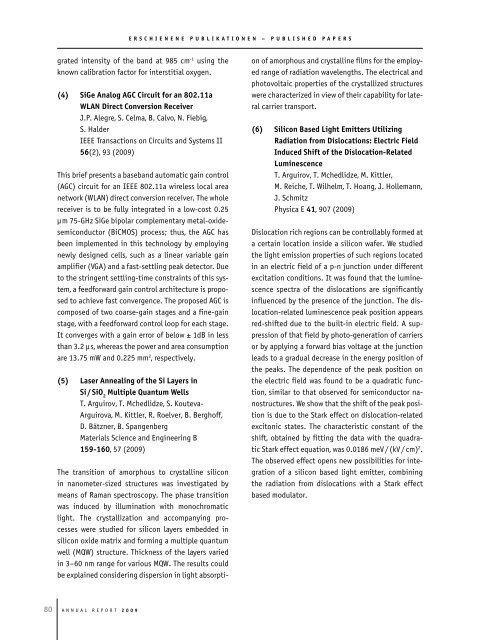Deliverables and Services - IHP Microelectronics
Deliverables and Services - IHP Microelectronics
Deliverables and Services - IHP Microelectronics
Create successful ePaper yourself
Turn your PDF publications into a flip-book with our unique Google optimized e-Paper software.
80 A n n u A l R e p o R t 2 0 0 9<br />
e r S C H I e N e N e p u B L I K A t I o N e N – p u B L I S H e d p A p e r S<br />
grated intensity of the b<strong>and</strong> at 985 cm -1 using the<br />
known calibration factor for interstitial oxygen.<br />
(4) SiGe Analog AGC Circuit for an 802.11a<br />
wLAN direct Conversion receiver<br />
J.p. Alegre, S. Celma, B. Calvo, n. Fiebig,<br />
S. Halder<br />
Ieee transactions on Circuits <strong>and</strong> Systems II<br />
56(2), 93 (2009)<br />
this brief presents a baseb<strong>and</strong> automatic gain control<br />
(AGC) circuit for an Ieee 802.11a wireless local area<br />
network (WlAn) direct conversion receiver. the whole<br />
receiver is to be fully integrated in a low-cost 0.25<br />
µm 75-GHz SiGe bipolar complementary metal-oxidesemiconductor<br />
(BiCMoS) process; thus, the AGC has<br />
been implemented in this technology by employing<br />
newly designed cells, such as a linear variable gain<br />
amplifier (VGA) <strong>and</strong> a fast-settling peak detector. Due<br />
to the stringent settling-time constraints of this system,<br />
a feedforward gain control architecture is proposed<br />
to achieve fast convergence. the proposed AGC is<br />
composed of two coarse-gain stages <strong>and</strong> a fine-gain<br />
stage, with a feedforward control loop for each stage.<br />
It converges with a gain error of below ± 1dB in less<br />
than 3.2 µs, whereas the power <strong>and</strong> area consumption<br />
are 13.75 mW <strong>and</strong> 0.225 mm 2 , respectively.<br />
(5) Laser Annealing of the Si Layers in<br />
Si / Sio 2 Multiple Quantum wells<br />
t. Arguirov, t. Mchedlidze, S. Kouteva-<br />
Arguirova, M. Kittler, R. Roelver, B. Berghoff,<br />
D. Bätzner, B. Spangenberg<br />
Materials Science <strong>and</strong> engineering B<br />
159-160, 57 (2009)<br />
the transition of amorphous to crystalline silicon<br />
in nanometer-sized structures was investigated by<br />
means of Raman spectroscopy. the phase transition<br />
was induced by illumination with monochromatic<br />
light. the crystallization <strong>and</strong> accompanying processes<br />
were studied for silicon layers embedded in<br />
silicon oxide matrix <strong>and</strong> forming a multiple quantum<br />
well (MQW) structure. thickness of the layers varied<br />
in 3–60 nm range for various MQW. the results could<br />
be explained considering dispersion in light absorpti-<br />
on of amorphous <strong>and</strong> crystalline films for the employed<br />
range of radiation wavelengths. the electrical <strong>and</strong><br />
photovoltaic properties of the crystallized structures<br />
were characterized in view of their capability for lateral<br />
carrier transport.<br />
(6) Silicon Based Light emitters utilizing<br />
radiation from dislocations: electric Field<br />
Induced Shift of the dislocation-related<br />
Luminescence<br />
t. Arguirov, t. Mchedlidze, M. Kittler,<br />
M. Reiche, t. Wilhelm, t. Hoang, J. Hollemann,<br />
J. Schmitz<br />
physica e 41, 907 (2009)<br />
Dislocation rich regions can be controllably formed at<br />
a certain location inside a silicon wafer. We studied<br />
the light emission properties of such regions located<br />
in an electric field of a p-n junction under different<br />
excitation conditions. It was found that the luminescence<br />
spectra of the dislocations are significantly<br />
influenced by the presence of the junction. the dislocation-related<br />
luminescence peak position appears<br />
red-shifted due to the built-in electric field. A suppression<br />
of that field by photo-generation of carriers<br />
or by applying a forward bias voltage at the junction<br />
leads to a gradual decrease in the energy position of<br />
the peaks. the dependence of the peak position on<br />
the electric field was found to be a quadratic function,<br />
similar to that observed for semiconductor nanostructures.<br />
We show that the shift of the peak position<br />
is due to the Stark effect on dislocation-related<br />
excitonic states. the characteristic constant of the<br />
shift, obtained by fitting the data with the quadratic<br />
Stark effect equation, was 0.0186 meV / (kV / cm) 2 .<br />
the observed effect opens new possibilities for integration<br />
of a silicon based light emitter, combining<br />
the radiation from dislocations with a Stark effect<br />
based modulator.










